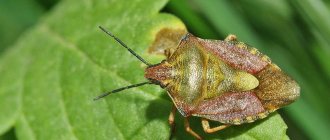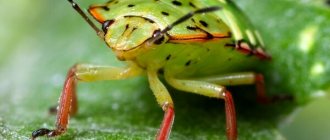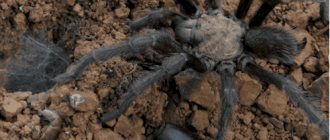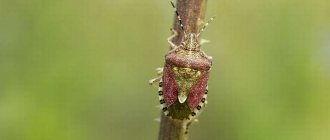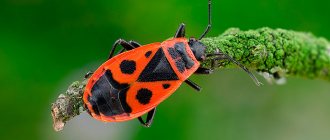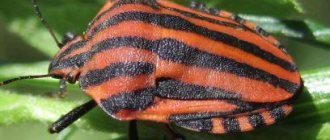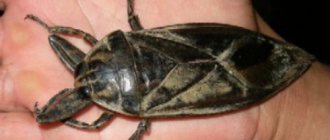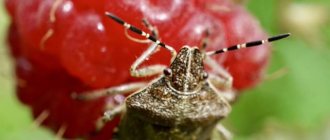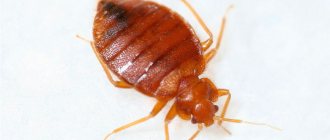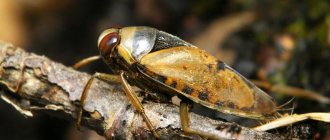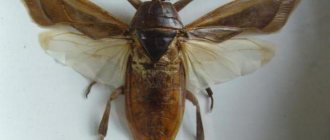Is the bug harmful or beneficial?
There are about 40 thousand species of bedbugs around the globe. Insects differ in color, body shape and lifestyle, but they all smell disgusting. Bedbugs that live in forests or gardens have glands in the lower part of their body that produce a secretion with an extremely unpleasant odor. It attracts individuals of the opposite sex and repels natural enemies.
Summer residents, owners of greenhouse farms, and workers at agricultural enterprises most often encounter stink bugs or stink bugs.
Shield insects can be divided into 3 categories:
- Herbivores (phytophages). They feed on leaves, young shoots, fruits of agricultural crops and other plants.
- Predatory. They eat harmful insects regardless of the stage of development (eggs, larvae, nymphs, adults). But in conditions of insufficient food, they can consume pollen and plant sap.
- Harmless. They prefer plant seeds and the remains of invertebrate animals. They do not pose a threat to agricultural land as long as the population size remains within normal limits. A striking example of harmless species is black and red soldier bugs.
All shield insects have a piercing-sucking mouthparts adapted for piercing a food source and sucking out liquid.
Who is he and where does he live?
There are very few places in Russia where you will not find this insect. His “home” is deciduous trees, shrubs, but he especially appreciates raspberry thickets. In the photo, the green bug can be recognized without any difficulty. The body is closer to a geometric shape rather than a round one. The body is flattened and consists of several chitinous scales that form a shell. Such shields reliably protect the insect from external influences and its wings from damage.
The green bug gets its name partly from its bright green carapace. The color is bright, like young spring greens. Closer to autumn, when the trees lose their already saturated colors and fade, the insect also changes the color of its shell.
The chitinous shells become yellowish, then beige, and by the onset of autumn cold they acquire a brown tint. Thus, the green forest bug has adapted to the surrounding space.
The wings are quite short, so their span is small. The insect flies noisily and over considerable distances, although it does this only when absolutely necessary. More often he sits quietly on the plant and moves very little. It behaves more actively only in the spring, when it is time to reproduce. Mating occurs right there on the branches where the insect feeds.
The female is capable of laying up to hundreds of eggs, securely attaching them to the back of the leaf. Moreover, during the summer she can leave offspring twice. The structure of the egg is peculiar, a round ball of light green color with a small lid, which then opens and releases the young larva into the wild. The embryo develops in the egg on average 10 days. A small bug that has just hatched is identical in appearance to an adult insect. The differences are minor, only the color and the lack of wings.
As it grows, the chitinous shell becomes tight. To turn into a large bug, the young individual undergoes a difficult period of molting, which occurs 5 times. The insect must get out of its tight shell on its own, and not all individuals can do this. During the molting period, a significant part of green bugs die. Those who survived and went through all stages of molting are able to acquire sizes of up to 1.5 cm.
With the onset of the cold season, the insect begins to search for shelter. Selects fallen leaves, crevices under the bark of trees and at the roots of plants for wintering. In winter, the bug is in a state of suspended animation.
Appearance
Residents of the middle zone are so accustomed to these representatives of the fauna that when they see a green, bug-like insect, they try to stay away. Features:
- an elongated body 12-14 mm long, similar in shape to a knight’s shield;
- upper body slightly pointed at the sides;
- bright green or brown color (changes depending on the time of year, helping the beetle to better camouflage itself in the foliage of trees);
- short wings with a small span (which is why the stink bug rarely flies);
- brown wing membrane, folded, located in the lower part of the body;
- triangular-looking head.
On a note! The shield plant has a special external digestion. The oral apparatus is represented by a proboscis, designed for piercing fruits with subsequent absorption of the processed mass. Food is digested from the outside using an enzyme contained in the bedbug's saliva.
Glands that release a substance with an unpleasant odor are located on the lower part of the body. It performs three functions at once: protection from natural enemies, attracting representatives of the opposite sex. In addition, the secreted secretion serves as a means of communication between bedbugs. For humans, the secretions of the green bug are not dangerous, but for other insects and birds they are poisonous.
Habitat
Green bugs are most often found in the garden, due to the presence of food. However, their natural environment is forest. The shield bug never chooses human dwellings as a habitat. The reason is the lack of nearby food sources. The tree bug will not travel long distances every time to find it.
Like most insects, the activity of stink bugs is limited to the warm season. With the onset of cold weather, it does not die, but falls into suspended animation, happily waiting for the summer. The green bug overwinters in tree bark or fallen leaves. The transformation that occurs at this point in its color (it becomes completely brown) makes the stink bug invisible and helps it survive the winter safely.
Reproduction
With the onset of warm weather, the mating season begins for insects. After the male fertilizes the female, she lays eggs and attaches them to the bottom of the leaf blade. The green bug (also known as the garden bug), under favorable climatic conditions, makes two clutches (up to 100 eggs each).
The bug plant presents clusters of balls of a beautiful light green color. After half a month, the larvae emerge from them. To facilitate the process, the eggs are equipped with a special lid. Newly hatched larvae have a brown tint and are not much different from an adult insect (except in the absence of wings).
How do garden bugs reproduce their species?
Reproduction occurs in the spring, starting in mid-April. The female lays 20-30 eggs measuring 1.3-1.6 mm, attaching them to the inside of the leaf. This prevents eggs from being detected and destroyed in time. The first larvae hatch after 35-45 days. Over the summer, the female manages to produce 3-4 generations. Larvae, like adults, are omnivorous and feed on the same plants and fruits.
Gastronomic preferences
Despite the fact that the shield bug is considered a herbivore (prefers plant juices, berries, less often attacks flowers and buds), when there is a lack of food, it becomes a scavenger (it sucks out dead caterpillars and other insects with its proboscis). The list of what green bugs mainly feed on includes:
- raspberries;
- currant;
- cherry;
- gooseberry;
- tomatoes;
- elder;
- cereal crops - chickpeas, soybeans, nightshades, rapeseed (in rare cases).
In the absence of berries, the food is the juices of deciduous trees and grass. Given the structure of the oral apparatus, green bugs cannot bite through the thick shell, so they are extremely rare on the bark.
Types of useful bugs for the garden
Among the large family of garden bugs, there are several predatory species that feed on the adults and larvae of agricultural pests.
Some greenhouse farms specifically breed these insects to use them against aphids, whiteflies, spider mites, and thrips:
- Perillus two centuries old. Representatives of the species are easily identified by a characteristic pattern of two triangles located near the head. On the territory of Russia they are found only in the Krasnodar Territory; they do not survive in regions with harsh winters. Adults are bright red and black in color. The stink bug effectively destroys egg clutches and eats larvae, adult beetles and butterflies. The basis of the diet of perillus are Colorado potato beetles, leaf beetles, and sawflies.
- Picromerus. The bug is brownish-brown in color with a bronze tint. The menu of this omnivorous shield insect includes up to 250 species of insects that harm agriculture. Picromerus is a useful bug for the garden.
- Macrolophus. This light green polyphagous bug destroys many parasites occupying flower beds and beds with cultivated plants. It prefers to feed on greenhouse and tobacco whiteflies, thrips, and tomato leafminers.
- Podizus. Adult bedbugs are gray-brown in color. Their body length does not exceed 1.2-1.4 cm. The insect’s diet includes about 90 species of lepidopteran and coleopteran pests. One Podiusus larva, depending on the stage of development, is capable of destroying from 5 to 12 Colorado potato beetle larvae, and a pair of adult individuals can destroy up to 200 larvae.
Picromerus, macrolophus, and subsus are grown in biological laboratories and sent to agrotechnical enterprises, where entomophages are used by people to combat Colorado potato beetles, caterpillars, moths, sawflies, and cutworms. Greenhouses with flowers and vegetables are infested with colonies of bedbugs even before pests begin to multiply, so that beneficial insects have time to increase their population.
Currant disease
Terry (reversion) is a mycoplasma disease. Currently, it is widespread in all areas of the Non-Chernozem Zone where black currants are cultivated. Terry also affects red and golden currants.
| Rice. 2. Currant branch affected by doubleness |
In affected plants, the shape of the flowers changes, they become double (Fig. 2), the ovary changes from lower to upper, leaves from five-lobed to three-lobed, the veins become coarser and sparser, small leaves and asymmetry are observed. The specific blackcurrant smell disappears. Branching increases, bushes thicken. The main carrier of this disease is the currant bud mite, as well as aphids, plant bugs and, possibly, the spider mite, which is widespread on currants.
Scientists have been studying the problem of black currant terry since 1912, but a method of complete control has not yet been developed on berry plantations. The difficulty is that it can take a long time from infection to the appearance of noticeable symptoms. The first signs of the disease in most affected bushes appear on the leaves (up to 70%), to a lesser extent - on the flowers. In addition, one of the properties of terry is the weakening of its signs in some years. The disease is masked. The bush seems to have recovered, but then the disease reappears. Sick currant plants are a source of infection, since the causative agent remains in these plants.
Terry disease spreads very quickly, but different varieties are affected to varying degrees.
Many varieties of the European group are severely affected. Of the zoned ones, Nina, Pobeda, and Stakhanovka of Altai are most affected. The most resistant among the known varieties are Golubka, Zoya, Koksa, Primorsky Champion and Naryadnaya.
It should be noted, however, that with the age of the bushes and the deterioration of agrotechnical care, the disease can appear on resistant varieties, and the degree of damage to non-resistant varieties increases sharply under these conditions. This applies to all diseases and pests.
How to fight this disease. It is necessary to pay the most serious attention to terry, since measures to combat it have not yet been developed. All activities are aimed at combating the vectors of this disease. The cutting of branches and even cutting them completely onto a stump does not give a positive result. Therefore, it is necessary to carefully examine the currant bushes for terry disease, and at the first signs of manifestation of this disease, the bushes must be removed and burned, and young plantings must be isolated from old plantings.
Types of bedbug pests
Phytophagous bugs suck juices from the shoots and leaves of agricultural crops, as a result of which the plants weaken and lose their ability to resist fungal, bacterial, and viral diseases. Species that feed on fruits are no less harmful. They inject enzymes into the bite area that dissolve the pulp and facilitate the absorption of nutrient fluid. Berries, vegetables, and fruits acquire an unpleasant odor, and the fruits themselves become unfit for consumption.
In our latitudes, summer cottages and farms suffer from several types of bedbugs:
- woody;
- marble;
- berry;
- cruciferous;
- pear;
- cucumber;
- beet;
- alfalfa;
- alder;
- harmful turtle;
- horsefly.
A massive pest invasion can reduce the yield of cereals, vegetables and fruits by 30-80%.
Interesting facts about shieldbills
Insects have a number of features that distinguish them from other arthropods, some of which people began to use for their own purposes. The most interesting facts:
- The unpleasant properties of the secretions of green bugs are used in the treatment of alcoholism. Dried shield bugs were infused into moonshine and given to a person with an addiction to intoxicating drinks to try. Such a treat would make anyone give up alcohol for a long time.
- Another interesting fact concerns the closest relative of the stink bug - the Japanese wood bug. Studies have revealed that he has maternal instincts. The female supplies the larvae with berries every day, resulting in hundreds of seeds remaining at the laying site.
- The Italian relative of the berry pest is gradually beginning to invade the middle zone. Outwardly it looks like a shield bug, but has an interesting coloring of the shell in the form of the flag of the Vatican guards. Several of these individuals are capable of destroying an entire crop harvest.
- If a tree beetle, sitting on a branch, sees a large moving object nearby, it will not fly away, but will simply crawl to the opposite part of the shoot. Therefore, a full-face photo of an insect is very rare.
Along with this, scientists have identified a number of interesting physiological features of the green beetle (color change, methods of communication, finding food and other characteristic features).
Despite the fact that the stink bug is not capable of causing harm to humans, it is better to limit contact with this insect. The appearance of an unpleasant odor is the lesser of the evils that a gardener faces when he discovers such a pest on his property. Its numbers must not be allowed to grow, otherwise there is a high risk of being left without a berry harvest.
How to recognize bedbugs on your property
Smelly parasites are easy to distinguish by appearance and habitat:
The bug is a harmful turtle.
- The imagoes of the tree stink bug are green. They have a kind of brown shield on the lower back. The body length is 1.1-1.6 cm. The wood bug settles on deciduous trees and shrubs, weeds and grasses. If raspberries are planted on the site, the pest will give preference to bushes with sweet berries.
- The marbled bug has a pear-shaped body. The size of the adult does not exceed 1-1.7 cm. The main color of the insect is brown. A pattern of alternating dark and light spots, reminiscent of a marble pattern, is visible on top; the underside of the body is white or light brown. Due to the lack of natural enemies, the number of marbled bugs is constantly growing. Parasites destroy the fruits of grapes, citrus fruits, and fruit trees. Insects are not sensitive to pyrethroids, making them difficult to control.
- The harmful turtle fully lives up to its name: it looks like a miniature reptile, its body with a characteristic brown-bronze pattern looks like a shell. The adult size does not exceed 1-1.3 cm. The parasite prefers cereal crops. Damaging the wheat stalks, it injects saliva, which provokes underdevelopment of the grains. During the migration period, harmful turtles can fly long distances (up to 50 km). With a lack of nutrition, they also harm other garden plants.
- The berry shield bug is almost invisible in the bushes among the fruits due to its reddish or brown color. It sucks juices from unopened buds, young leaves and berries. The length of adult individuals is 1-1.2 cm. The flat body of the imago is covered with an intricate pattern: on top there is a yellow-brown shield, on the abdomen there is a black rim with yellow stripes, and on the black mustache there are yellowish rings.
- The cruciferous bug is a medium-sized insect (0.5-1 cm), two- or three-colored in color, combining black, bright yellow, red or white shades. Insects parasitize cruciferous crops and cause great damage to seedlings and young shoots.
- Pear lace is miniature - only 2.8-3.3 mm. Her body and wings are painted in a nondescript beige color, covered with an openwork mesh of translucent cells. The prolific parasite lives on deciduous and fruit trees. Most often, pear, plum, apple, linden, and apricot trees suffer from it.
- The cucumber bug is an insect up to 3 mm long. Prefers to settle on the underside of cucumber leaves. Does not disdain tomatoes, eggplants, sweet peppers. Several sexually mature females can give rise to a large population that in one season will infect an entire plot or greenhouse.
It is advisable to fight stink bugs using chemical or folk methods when their number is 2 or more individuals per plant. In other cases, collecting by hand or using an exhauster, a device for catching insects, will help prevent the development of the population.
Habitat
Garden bugs have chosen as their habitat areas where various crops are planted, orchards with fruit trees, and forests. Garden bugs are widespread and varieties can be found on every continent except Antarctica.
What does it eat?
The diet of the garden bug is the green part of cultivated plants, fruits and foliage of fruit trees, as well as cereal crops.
Signs of appearance
Regular inspection of plants will help you notice the presence of harmful bugs in the area in a timely manner. At an early stage, you can notice the larvae, which are localized on the back of the leaves. If the lesion is already beginning to gain momentum, then small holes can be seen on the leaves of trees, shrubs and garden plants.
What do bedbugs eat?
Garden pests feed on everything that grows on the site. Some types of bedbugs love vegetables, others love berries and fruits, others love leafy greens and young shoots, and others love grains. You can most often find out about the preferences of a pest by its name.
For example, the berry stink bug destroys the fruits of raspberries, currants, strawberries, sea buckthorn, and other shrubs. The cruciferous bug chooses plants of the Cruciferous family (cabbage, radish, radish, celery, horseradish, mustard) as its habitat. But some types of bedbugs are not selective and eat everything that is in close proximity.
Prevention of insects
Agrotechnical measures will help to significantly reduce the “number” of tree bugs on the site. For the winter, pests settle under fallen leaves, where they safely wait out the cold. In the spring, they crawl out pretty hungry and continue their destructive activities. Cleaning up fallen leaves, tops and other plant debris followed by burning will destroy most of the bedbugs that have comfortably settled down to rest. If you also dig up the soil, there is a high probability that you will not encounter green bugs at all next year.
Are they dangerous for humans?
Unlike bed bugs, herbivorous and predatory species are safe for humans. The only trouble that awaits urban and rural residents is the smell that insects leave on plants or emit at the slightest danger.
Herbivorous insects are safe for humans.
Do they bite or not?
Garden pests cannot bite through human skin. Their soft proboscis is adapted for sucking juices from tender leaves and shoots. The digestive system of bedbugs is not able to digest human blood. Therefore, it is impossible to get a bite from a country or forest stink bug.
The exception is the predatory bug, which feeds on small invertebrate animals. Theoretically, its long proboscis could pierce the skin of an adult or child and cause pain. But before this happens, the person will have time to brush off the pest, which reaches a length of 1.5-2 cm.
Expert advice
Evgeniya Vitalievna Marinina, entomologist, 16 years of work experience:
Marinina Evgenia Vitalievna Entomologist, researcher.
Work experience 16 years. • if in the spring you remove the remains of plants after winter and plant repellent plants, this will help reduce the number of bedbugs and it will be easier to fight them; • the method of destruction depends on the type of parasite, for example, currant insects can go unnoticed, many remedies that are effective against stink bugs do not work against them, so carefully inspect your plants, watch for changes in the shape and size of all parts, including the buds; • if folk remedies are used, we must not forget to re-treat the area when decoctions and infusions are sprayed irregularly, this negates the entire protective effect.
Soapy water is a safe method of pest control
How plants die from bugs
The invasion of garden bugs begins with the appearance of several individuals on the site. Sexually mature females do not like to travel: they settle on one plant, mate with males and lay eggs. Within 10-14 days, several dozen new insects hatch and begin to actively feed. Pests inject enzymes into plants that dilute plant juices and facilitate the absorption of liquid.
After a month, the larvae turn into adults, which give rise to a new generation of bedbugs. After 1-2 months, the exponentially multiplying population can destroy the vegetation in the chosen area, be it a flower bed or a bed with vegetables or grains.
Septoria disease
Septoria, or white spot , is widespread. It mainly affects leaves, which are covered with round or angular spots (2-3 mm in diameter), first brown and then white with a narrow brownish border. On the spots there are small black dots - pycnidia of the parasite. Severely damaged bushes lose all their leaves ahead of time, are stunted in growth, and their yield is sharply reduced. The main source of infection is fallen leaves.
Measures to combat the disease are the same as for anthracnose.
Control measures
Traditional agrotechnical practices will help prevent the spread of bedbugs: adherence to planting dates, regular fertilizing, weeding, and timely watering. This will strengthen the immunity of cultivated plants and increase their resistance to pests. It is necessary to destroy weeds and excess organic matter - mown grass or fallen leaves, in which larvae and adult stink bugs often overwinter.
Another preventive way to prevent stink bugs from multiplying is to plant black cohosh along the perimeter of the site, at separate points or along paths. This perennial is popularly called black cohosh or black cohosh. The leaves and stems of the luxuriously flowering plant contain juice that is poisonous to bedbugs, but harmless to humans. Black cohosh flowers and leaves emit a pleasant aroma that insects cannot tolerate. Cohosh is easily propagated by seeds or by dividing the bush, does not require special care, blooms before frost, and lasts a long time when cut.
Chemicals
Not every chemical affects representatives of the suborder of bedbugs.
To get rid of a colony of parasites, insecticides are suitable:
Actellik is an ideal insect repellent for plants.
- “Aktellik”;
- “Alatar”;
- “Arrivo”;
- “Decis Profi”;
- “Spark double effect”;
- "Colibris";
- “Murakha”;
- “On the spot.”
When using chemicals, it is necessary to observe safety precautions and adhere to the manufacturer’s recommendations; during the preparation of the working fluid, do not change the concentration of the active substance.
Traditional methods
The principle of destroying garden parasites using folk methods is to spray crops with decoctions and infusions of plants:
- Pour 100 g of dry mustard powder into a 10-liter bucket, pour in 0.5 liters of hot water and stir. Add another 9.5 liters of water. Spray the suspension onto the plants, trying to wet both the upper and lower parts of the leaf blades.
- Pour 10 liters of hot water into a bucket, add 200-300 g of onion peels and leave for 3-5 days. Strain before use. In a similar way, you can prepare wormwood tincture.
The use of herbal decoctions and tinctures does not always get rid of pests the first time; 2-3 treatments may be required at intervals of several days. But such products are safe for people, birds, and warm-blooded animals.
Reviews from gardeners
Larisa, 45 years old, Tambov. In my garden, stink bugs quickly disappear when I douse the plants with soapy water. Moreover, I make the solution more concentrated, then the result is better and lasts longer. Olga, 38 years old, Izhevsk, I always keep my garden clean: I remove weeds, treat it with onion peels. I haven’t noticed any addiction in insects, because every spring I start with this product. So far it has worked well. Maxim, 37 years old, Yaroslavl. Bugs eat my raspberries. The harvest is impossible to harvest - the smell is terrible, the taste is too. I use the product to treat the area in the spring. Nothing else helped, but perhaps it’s the quantity – we always have a lot of bedbugs.
Bedbugs love to eat raspberries
How to find garden bugs in a house or apartment
In the warm season, single insects can fly into an apartment or house through open doors and windows. Finding a lost bug is easy - its bright green or variegated color will give it away. Garden bugs are not adapted to life in enclosed spaces: they do not like succulents, cacti, plants with dense waxy leaves, poisonous milky sap (Monstera, Epipremnum, Euphorbia, Dieffenbachia, etc.). But even if insects take a fancy to some indoor flower, they can be easily detected during the next watering, collected by hand and destroyed.
Furrow mower: spring treatment of blackcurrant bushes from pests
Sulcata mower Otiorrhynchus sulcatus Fabr.
Weevil beetle 8-10 mm long, pitch-black, with a metallic sheen, hips with a tooth. The rostrum is clearly expanded at the apex; it has a deep and wide longitudinal groove. Spring treatment of currants against pests of this type includes collecting and burning all plant residues. Then the treatment of currant bushes from pests is carried out by spraying them with insecticides.
The larva is small, white, legless, cylindrical, somewhat curved, with a brown head. The larvae feed and develop in the roots of plants, making passages in the wood. The beetles damage the leaves, eating the edges in small areas, shallowly, in a patterned manner, and also damage the buds. The furrow mower often damages currants, raspberries, grapes, apricots and deciduous shrubs and trees.
Control measures. Preventive treatment of black currants against pests after flowering with one of the drugs: fufanon, kemifos, actellik.
How to take garden bugs for alcoholism
Proponents of traditional medicine claim that bedbug tincture helps develop an aversion to alcohol. In appearance, smell and taste it is no different from vodka. But after consuming this tincture, the patient experiences unpleasant symptoms (nausea, vomiting), which sharply reduce the craving for alcohol.
Tincture for garden bugs
To prepare the tincture, you need to catch 5-7 adult woodworms in your dacha or garden, fill them with vodka or alcohol (250-500 ml), and leave for 10 days. It is recommended to store the container in a dark place at room temperature. The finished tincture should be strained.
You should not tell the patient that this is a homemade drink; it is better to pass it off as a store-bought product or add it to strong alcohol: vodka, whiskey, rum, etc. Many people who suffer from a craving for alcohol develop disgust after the first glass of tincture, but To consolidate the result, the procedure can be repeated several times.
Why is it undesirable to crush stink bugs?
Think before you squash a tree bug. When many people find a wood bug, their first instinct is to squash it.
However, when crushed, stink bugs tend to release a foul-tasting odor from pores on the sides of their bodies. This smell does not disappear for a long time and attracts smelly fellows.

